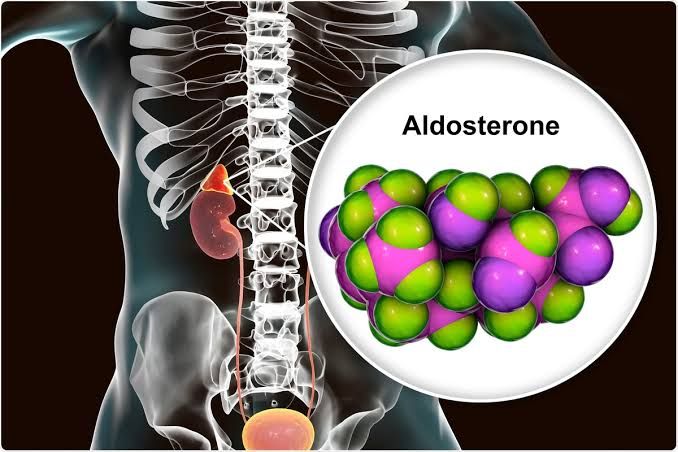
Physiological Effects of Mineralocorticoids (Aldosterone)
Aldosterone, the primary mineralocorticoid hormone, plays a crucial role in maintaining electrolyte balance, blood pressure regulation, and fluid homeostasis. It is synthesized in the zona glomerulosa of the adrenal cortex and acts primarily on the distal nephron of the kidney. Its physiological effects include:
- Sodium Reabsorption: Aldosterone promotes sodium reabsorption in the distal tubules and collecting ducts of the nephron by increasing the expression and activity of epithelial sodium channels (ENaCs) and sodium-potassium ATPase pumps. This action increases sodium retention in the bloodstream, which subsequently raises blood volume and blood pressure.
- Potassium Excretion: Aldosterone enhances potassium excretion by stimulating potassium channels in renal tubular cells. This helps maintain normal serum potassium levels.
- Hydrogen Ion Secretion: Aldosterone also facilitates hydrogen ion excretion through its actions on intercalated cells in the collecting ducts, contributing to acid-base balance by preventing metabolic acidosis.
- Water Retention: By promoting sodium reabsorption, aldosterone indirectly increases water retention due to osmotic gradients created by higher sodium concentrations in the bloodstream.
- Effects Beyond Kidneys: Aldosterone also acts on other tissues such as sweat glands, salivary glands, and intestinal epithelium to regulate sodium conservation under conditions like dehydration or low blood pressure.
Regulation of Aldosterone Secretion
The secretion of aldosterone is tightly regulated by several physiological mechanisms to ensure proper electrolyte balance and blood pressure control:
- Renin-Angiotensin-Aldosterone System (RAAS):
- The RAAS is the primary regulator of aldosterone secretion.
- When blood pressure drops or there is reduced renal perfusion (e.g., due to hypovolemia), juxtaglomerular cells in the kidneys release renin.
- Renin converts angiotensinogen (produced by the liver) into angiotensin I.
- Angiotensin I is converted into angiotensin II by angiotensin-converting enzyme (ACE) in the lungs.
- Angiotensin II directly stimulates aldosterone secretion from the adrenal cortex while also causing vasoconstriction to raise blood pressure.
- Serum Potassium Levels:
- Elevated serum potassium levels stimulate aldosterone secretion to enhance potassium excretion through urine.
- Conversely, low potassium levels suppress aldosterone production.
- Adrenocorticotropic Hormone (ACTH):
- ACTH from the anterior pituitary gland transiently stimulates aldosterone secretion but does not play a significant role in long-term regulation.
- Atrial Natriuretic Peptide (ANP):
- ANP, released from cardiac atria during hypervolemia or increased atrial stretch, inhibits aldosterone secretion as part of its role in reducing blood volume and pressure.
- Other Factors:
- Local adrenal dopamine inhibits aldosterone synthesis.
- Corticosteroids, estrogen, and thyroid hormones can modulate RAAS activity indirectly affecting aldosterone levels.
Clinical Consequences of Hypo- and Hyperaldosteronism
1. Hyperaldosteronism
Hyperaldosteronism refers to excessive production of aldosterone and can be classified as primary or secondary.
- Primary Hyperaldosteronism (Conn’s Syndrome):
- Caused by an aldosterone-producing adenoma (APA) or bilateral adrenal hyperplasia.
- Leads to hypertension due to excessive sodium retention and increased extracellular fluid volume.
- Causes hypokalemia due to enhanced potassium excretion, resulting in symptoms such as muscle weakness, fatigue, polyuria, polydipsia, constipation, arrhythmias, or even paralysis if severe.
- Secondary Hyperaldosteronism:
- Results from overactivation of RAAS due to conditions like renal artery stenosis or heart failure.
- Symptoms are similar but often accompanied by underlying disease-specific manifestations like edema.
2. Hypoaldosteronism
Hypoaldosteronism refers to insufficient production or impaired function of aldosterone.
- Causes include Addison’s disease (adrenal insufficiency), congenital adrenal hyperplasia (CAH), diabetic nephropathy affecting renin release, or medication-induced suppression (e.g., ACE inhibitors).
- Clinical consequences include:
- Hyponatremia: Low serum sodium levels lead to hypotension and dizziness.
- Hyperkalemia: Reduced potassium excretion causes muscle weakness or cardiac arrhythmias.
- Metabolic Acidosis: Impaired hydrogen ion excretion results in acid-base imbalance.
- Symptoms may vary depending on severity but often include fatigue, salt craving, nausea/vomiting, weight loss (in Addison’s disease), darkened skin pigmentation due to elevated ACTH levels stimulating melanocytes.







